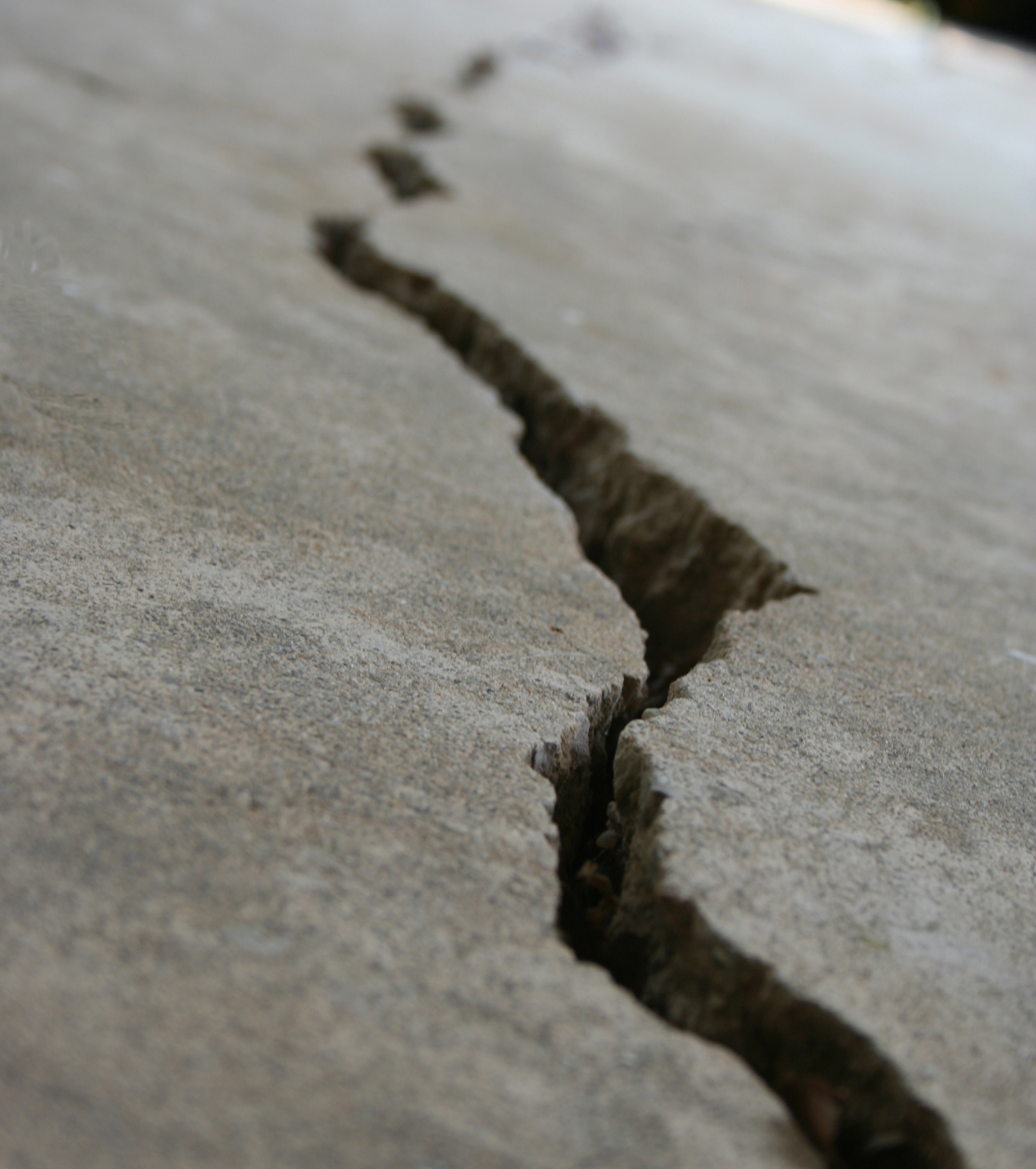Home » Structural » Concrete slab »
Fill the crack with urethane caulk, similar to what you would use for driveway caulk. It works perfectly as a concrete expansion joint sealant. Snip the opening of the tube at a 30-degree angle, making the opening the same size as your gap. Use a smooth, even motion, filling the crack flush with the surface, beveling it if it's against the house. Vacuum the crack to remove all of the dust and debris. Apply duct tape along both sides of the entire crack, and apply an epoxy-based resin into the crack. Fill the crack entirely with the resin.
Mix the concrete patching compound, following the manufacturer's directions. Trowel the compound into the crack. Stab the trowel into the compound to remove air pockets and help work the patching material deep into the crack. Fill the crack up to the surrounding concrete surface. Pour concrete resurfacing mixture into the crack and smooth it out with a rubber floor squeegee. Feather the edges to get the best appearance. Add water to the resurfacer mix to get the consistency of pancake batter for the concrete crack filler. Then fill the remainder of the groove and smooth it over.
Cracks in a concrete garage floor may indicate that there are foundation problems or other issues. As buyers or owners, we want know how to tell if they’re serious; basically when to worry.
The good news is that most cracks in garage floors are common and not an indication of serious structural issues, however there are a few that indicate that maintenance is needed or that there may be a structural concern. Ben 10 protector of earth ps2 game download.
Cold joints look like cracks but are OK
One of the most common mistakes that people make when looking at their garage floor is to confuse a cold joint with concrete that has actually cracked.
A cold joint is intentionally placed in concrete by the concrete contractor when he is pouring the concrete. Basically a cold joint is where a section of concrete has been poured and then after it has hardened they pour another section of concrete next to it. Some people may confuse these joints with control joints.
Control joints and cracks
Many concrete contractors will say that there are two types of concrete. “Concrete that has cracked and concrete that is going to crack.” This saying has a lot of truth to it.

Since contractors and engineers know that most concrete is going to crack, they like to control where it is going to crack. They accomplish this by placing control joints in concrete slabs, often 10 to 20 feet apart and in both directions. These control joints are designed to weaken the concrete in certain areas, so that the concrete will crack in a straight line in these areas. They may be troweled into the concrete or thin plastic strips may be embedded in the fresh concrete to weaken it. A good example is a long side walk that has control joints about every 5 to 10 feet. (Read more about concrete joints)
In garage floors contractors use mostly control joints and occasionally cold joints. Neither of these are inherently bad and are seldom a problem.
New Homes’ – Cracks that occur in the first few months or years
Shrinkage cracks
When a garage floor is first poured, the concrete begins to harden (contractors say cure) and when this process takes place the concrete shrinks a little; a 20 foot square of freshly poured concrete will shrink about a 1/8 of an inch in each direction. As this happens small shrinkage cracks appear in the concrete. These are normal and generally are not much of a concern. (Read more about concrete shrinkage cracks)
Cracks from a new home settling
In the first year or two it is not uncommon for a new homes’ foundation to settle a bit. As this settling takes place the slab will often develop a few cracks due to this settling, but in the overall picture, these likewise will normally not be of much concern.
Cracks during construction
Builders often say that “Time is money” and therefore push the contractors and sub-contractors to get their work done sooner.
In this haste the framing contractor often wants to start framing the house as soon as the foundation and slab is poured. From a technical stand point the concrete needs some curing time before anything heavy can be placed on it; the concrete needs to achieve a certain strength before heavy lumber and equipment gets onto the concrete. Depending on the type of concrete it usually takes 5 or 10 days and even up to 4 weeks before heavy equipment and loads can safely get onto a concrete slab; most concrete reaches full strength in approximately 28 days.
If a framing contractor drives a piece of heavy equipment loaded with lumber onto a 4 inch thick concrete slab, he may crack the green (not fully cured) concrete
Crazing cracks
Very thin hairline cracks in random or irregular hexagonal patterns that are very shallow, usually less than an 1/8 of an inch deep, are often called crazing cracks. They are caused by improper troweling and placement of the concrete; the thin top layer of concrete dries out faster than the rest of the concrete, thus these hairline cracks. They are generally of no concern when it comes to structural integrity. You are more apt to see these types of cracks on a garage floor that has a hard smooth troweled surface than one that has a broom finish.
Cracking due to poor compaction of sub-grade
Before pouring a concrete slab it is important to prepare what is often called the subgrade which usually involves compacting the sub-grade and base (i.e. gravel and /or sand on top of the sub-grade). If these sub layers are not well compacted then when concrete is poured on top of them, the heavy weight of the concrete will cause these areas to drop down a little, then cracking may occur.
Slab reinforcement: Rebar, Post tension cables or Wire mesh
One of the most important aspects of a concrete slab is the steel reinforcement in the slab. It reduces cracking and makes the slab much stronger.
Rebar
Rebar steel reinforcement is probably the most common form of reinforcement used in concrete slabs for the last 40 to 50 years. This type of reinforcement is usually placed at 12, 16 or 24 inches on center in each direction of a garage slab. The majority of these slabs are about 4 inches thick, however a few may be 5 or 6 inches thick.
If you see a cracking or rusting pattern in the garage floor that looks like the cracks are 12 to 24 inches apart running in one or two directions, it may be an indication that the rebar was place a little too high and doesn’t have enough concrete to properly cover the rebar. Usually these hair line cracks will run parallel to one another. (Read about rebar problems and warning signs of problematic rebar in concrete)
Post tension slabs
Post tension slabs have steel cables that run through them, similar to rebar but are further apart. After about seven days these cables are stretched tightly with hydraulic jacks which puts the slab under compression and helps spread the weight (load of the house) over a wider area than the footings alone. This type of reinforcement is becoming more popular and is now used more often in areas that have expansive soils. (Read more about post tension slabs and why you should not cut or core one)
If a garage has a post tension slab there is usually either a sign stamped in the concrete floor saying it is a Post Tension slab or a plastic sign on the garage wall stating it’s a Post Tension slab. Remember that you should not saw cut the slab or core holes in it for safety reasons.
Wire mesh
There are a number of garage floors that have welded wire mesh reinforcement in them. The wire mesh usually comes in rolls or sheets and is placed in the concrete slab, approximately in the center of the slab; in a 4 inch thick slab it would be about 2 inches from the top and 2 inches from the bottom or the slab. In some cases this wire mesh does not end up in the center area but lays on the subgrade with concrete just poured over it, thus it doesn’t perform as well as it is designed to.
A concrete slab without reinforcement will crack substantially more than a reinforced slab and is weaker.
A concrete slab without reinforcement usually will have more cracks and the cracks will be wider than cracks in a reinforced slab. Nearly all newer homes will have reinforced slabs, however older homes, especially those built in the early sixties or before may not have reinforcement or very little.
Photo on left is an extreme example of a concrete slab without steel reinforcement. Keep in mind a slab without steel reinforcement usually does not look as bad as the photo but is more prone to cracking, than a slab without reinforcement.
Tip. If a concrete slab has a crack where one side of the crack is an 1/8, 1/4, or 1/2 inch higher than the other side, then there is a pretty good chance that there is no rebar or other reinforcement in the slab; for if there was reinforcement, both side would be roughly level, not offset.
Structural concerns
When a garage floor has a significant number of cracks or that they’re wide cracks or when a crack has one side substantially higher than the other side; then examining these cracks further and checking the home for other signs of possible soil and foundation movement would be wise.
Look at more than just the cracks
In order to help analyze if the cracks are a concern, you must look at other factors in the home. If you see some of the following, then the cracks may relate to foundational or other issues.
- Are the floors of the house sloping? Un-level floors are a sign of structural movement.
- Are there doors or windows that are inoperative or difficult to open or shut?
- Is the foundation cracked, leaning or bowed?
- Does the roof sag?
- Are there cracks in the drywall or siding?
- Does a crack across the garage floor continue up the garage wall?
When there are other issues like those above with a house, then garage floor cracks become more of a concern, for they are then part of the overall picture of the home and may relate to foundation issues.
Note. If a home is on a hillside lot and there is a living area or an open space area underneath the concrete garage floor, then all cracks should be evaluated for safety purposes. Should the cracks have rust stains, run extended lengths, be more than hairline cracks or getting worse; consulting a structural engineer would be wise.
Bottom Line
It is common for garage floors to develop cracks, some of which appear right after the floor is poured (i.e. shrinkage cracks). Others appear over the first year or so from the house settling slightly.
Older homes and homes built on expansive soils tend to have more cracks but even if they do, the question becomes if the cracks are significant or just normal for the age and geographic area.

Although there are many reasons for a concrete slabs to crack, most do not lead to serious foundation or structural issues; however there are times that the cracks are a warning sign of foundational or other problems. In these cases an owner or buyer should check a number of other things about the house in order to help determine the seriousness.
If you are just looking to fill in the cracks try a concrete epoxy.
Articles related to garage floors cracking:
Gaps under the garage door corners may indicate structural movement.
Tree roots near the garage can crack the floor through transpiration.
How to know when foundation cracks are serious.
How To Fill Large Cracks In Concrete Floor
How to minimize damage to a home from expansive soils.
Will your homeowners insurance policy cover damage to your foundation?
How To Fix Large Cracks In Concrete Floor
Additional Resources
Settlement may cause damage to a house, but some settlement can be prevented or reduced.
Cs tool crack 2019. How to repair a concrete crack depends on whether its a shrinkage crack, an 'Active' or 'Dormant' crack or a structural one.
Know which ceiling cracks are serious and which ones are cosmetic.
How long will a house last is a question that many wonder about when they buy a house.
There are a few times that cracks in a garage floor are a warning sign of foundation or other problems; can you recognize them?
Deteriorated concrete may be a sign of a number of things. For example, the area at the bottom of the garage door is deteriorated. Buyers often wonder if this is structural.
Cracks in concrete pool decks are common, however they may be a warning sign of deck problems or leaks.
Control joints reduces random cracking and damage to concrete. Having them in the right place is important.

